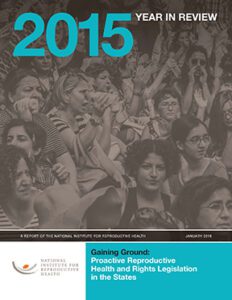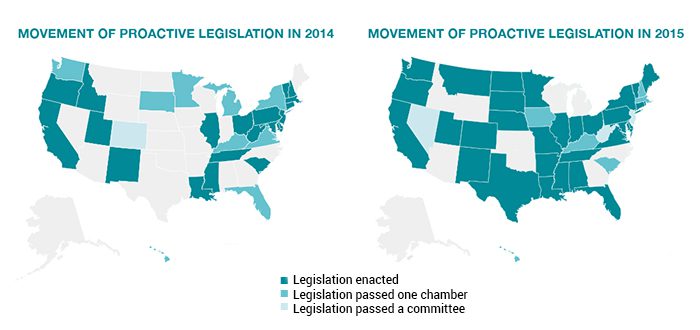2015 Proactive Year in Review
[fusion_builder_container hundred_percent=”yes” overflow=”visible”][fusion_builder_row][fusion_builder_column type=”1_1″ background_position=”left top” background_color=”” border_size=”” border_color=”” border_style=”solid” spacing=”yes” background_image=”” background_repeat=”no-repeat” padding=”” margin_top=”0px” margin_bottom=”0px” class=”” id=”” animation_type=”” animation_speed=”0.3″ animation_direction=”left” hide_on_mobile=”no” center_content=”no” min_height=”none”][fusion_title size=”2″ content_align=”left” style_type=”single solid” sep_color=”” class=”” id=””]2015 Policy Report
Gaining Ground: Proactive Reproductive Health and Rights Legislation in the States[/fusion_title][fusion_text]
In 2015, advocates and legislators made great gains in promoting legislation that affirmatively supports women’s reproductive and sexual health, rights, dignity, and autonomy.
The number of proactive reproductive rights and health bills, both proposed and enacted, more than doubled from 2014 to 2015, with all but 10 states considering such policies and the majority considering multiple pieces of legislation.[/fusion_text][/fusion_builder_column][fusion_builder_column type=”1_1″ background_position=”left top” background_color=”” border_size=”” border_color=”” border_style=”solid” spacing=”yes” background_image=”” background_repeat=”no-repeat” padding=”” margin_top=”0px” margin_bottom=”0px” class=”” id=”” animation_type=”” animation_speed=”0.3″ animation_direction=”left” hide_on_mobile=”no” center_content=”no” min_height=”none”][fusion_title size=”2″ content_align=”left” style_type=”single solid” sep_color=”” class=”” id=””]2015 Facts[/fusion_title][/fusion_builder_column][fusion_builder_column type=”1_1″ background_position=”left top” background_color=”” border_size=”” border_color=”” border_style=”solid” spacing=”yes” background_image=”” background_repeat=”no-repeat” padding=”” margin_top=”0px” margin_bottom=”0px” class=”” id=”” animation_type=”” animation_speed=”0.3″ animation_direction=”left” hide_on_mobile=”no” center_content=”no” min_height=”none”][fusion_checklist icon=”fa-check” iconcolor=”#00c5db” circle=”” circlecolor=”#” size=”small” class=”” id=””][fusion_li_item icon=””]40 states and D.C. took action to advance reproductive health and rights.[/fusion_li_item][fusion_li_item icon=”fa-check”]76 proactive bills passed in 31 states.[/fusion_li_item][fusion_li_item icon=”fa-check”]143 proactive policies moved through at least one committee in a state legislature.[/fusion_li_item][fusion_li_item icon=””]2015 represented a significant uptick from 2014, when 70 bills moved in 32 states, with 30 becoming law.[/fusion_li_item][/fusion_checklist][fusion_separator style_type=”none” top_margin=”” bottom_margin=”” sep_color=”” icon=”” width=”” class=”” id=””/][fusion_text]
[/fusion_text][fusion_separator style_type=”none” top_margin=”” bottom_margin=”” sep_color=”” icon=”” width=”” class=”” id=””/][fusion_text]Gaining Ground: Proactive Reproductive Health and Rights Legislation in the States details the growing trend of advocates and legislators working to not only introduce, but move and pass proactive reproductive and sexual health and rights legislation.
This second annual policy report focuses on legislation that passed at least one legislative committee, within four proactive policy areas.[/fusion_text][fusion_separator style_type=”none” top_margin=”” bottom_margin=”” sep_color=”” icon=”” width=”” class=”” id=””/][/fusion_builder_column][fusion_builder_column type=”1_1″ background_position=”left top” background_color=”” border_size=”” border_color=”” border_style=”solid” spacing=”yes” background_image=”” background_repeat=”no-repeat” padding=”” margin_top=”0px” margin_bottom=”0px” class=”” id=”” animation_type=”” animation_speed=”0.3″ animation_direction=”left” hide_on_mobile=”no” center_content=”no” min_height=”none”][fusion_title size=”2″ content_align=”left” style_type=”single solid” sep_color=”” class=”” id=””]Proactive Policy Content Areas[/fusion_title][/fusion_builder_column][fusion_builder_column type=”1_1″ background_position=”left top” background_color=”” border_size=”” border_color=”” border_style=”solid” spacing=”yes” background_image=”” background_repeat=”no-repeat” padding=”” margin_top=”0px” margin_bottom=”0px” class=”” id=”” animation_type=”” animation_speed=”0.3″ animation_direction=”left” hide_on_mobile=”no” center_content=”no” min_height=”none”][fusion_accordion class=”” id=””][fusion_toggle title=”Protecting and expanding access to abortion, contraception, and sexual health care” open=”no”]Sixteen states considered ways to protect and expand access to sexual and reproductive health care and 13 new state laws were enacted in nine states that will improve access to this care.
Highlights:
California enacted the Reproductive FACT Act, which requires all licensed medical facilities to inform patients of free and low-cost family planning programs, and crisis pregnancy centers to clearly inform their clients that the facility is “not licensed as a medical facility” and “has no licensed medical provider” available to provide medical services.
Florida passed Senate Bill 7016, extending a state law protecting a young woman’s confidentiality should she seek a court order to receive abortion care.
Oregon passed a new law allowing a woman to get both oral contraceptives and hormonal patch contraception from a pharmacist without needing to get a prescription from her primary care physician.
Maryland adopted four new laws in 2015 that expanded access to sexual health care, including two related to expedited partner therapy (EPT), a clinical practice where doctors provide treatment for some kinds of sexually transmitted infections (STIs) for both the patient and the patient’s sexual partner without also examining the partner.
Alabama passed House Bill 247, which would have allowed HIV clinics to redistribute unused HIV drugs to patients, but Governor Robert Bentley vetoed the bill.[/fusion_toggle][fusion_toggle title=”Enhancing insurance coverage for sexual and reproductive health care” open=”no”]15 states and the District of Columbia moved legislation aimed at expanding insurance coverage for reproductive and sexual health care services. Twelve new laws were enacted in eight states (Connecticut, Illinois, Louisiana, Maine, Montana, New York, Oregon, and Vermont) and the District of Columbia.
Highlights:
Illinois and Oregon enacted laws to address issues that arise for dependents on an insurance plan.
Maine successfully enacted a bill that allows residents at or below 209 percent of the federal poverty rate to access pregnancy prevention services as well as testing and treatment for STIs and cancer.
New York became the first state to add pregnancy to the list of qualifying life events, allowing someone who becomes pregnant to purchase insurance on the exchange immediately.
Legislators in Illinois and Washington attempted to expand insurance coverage specifically for abortion.[/fusion_toggle][fusion_toggle title=”Improving the sexual and reproductive health of youth” open=”no”]Legislation was introduced in 15 states aimed at strengthening sexuality programs, expanding access to sexual health services, addressing teen pregnancy, and supporting pregnant and parenting youth. Eight states sought to improve sexual health and sexuality education, with the majority considering measures that would add important information to their current sexual education curricula. Five of these bills passed in four states, along with a resolution in another.
Highlights:
California enacted Assembly Bill 329, which expands existing law to require that all public school students in grades 7-12 receive comprehensive sexual health education from appropriately trained teachers, including information about STIs other than HIV/AIDS, all FDA-approved forms of contraception, parenting, abortion, and adoption.
Six states considered and three enacted legislation to improve the sexual health of youth. Five of those – Hawaii, Indiana, Nevada, South Carolina, and Washington – moved legislation to expand access to HPV vaccinations for youth.
Four states considered bills to address teen pregnancy; a bill in Arkansas requiring the development of a plan to address the prevention of unplanned pregnancy and identify barriers to education for pregnancy and parenting youth was passed, as well as a bill in California requiring breastfeeding accommodations for students in public schools.[/fusion_toggle][fusion_toggle title=”Promoting healthy pregnancies, parents, and babies” open=”no”]More than half of all states considered legislation designed to promote healthy pregnancies, produce better birth outcomes, and support new parents. Twelve states considered and nine enacted legislation to expand access to or improve the quality of health care for pregnant women. The enacted bills included legislation focusing on the health of incarcerated pregnant women, legislation expanding the range of health care that advanced practice clinician midwives can provide and the settings in which health care can be provided, and legislation intended to more generally expand and promote care for pregnant women.
Four states considered (and Maryland enacted) legislation to study and improve maternal health and reduce mortality and morbidity. Ten states considered and five enacted bills that would improve the treatment of pregnant women on the job. Nebraska’s new law will require employers to provide a range of reasonable accommodations to employees who are pregnant, postpartum, or have related medical conditions, and it will prohibit employers from discriminating on the basis of pregnancy, recent childbirth, or related medical conditions.
Twelve states considered legislation to expand or enact protections for nursing mothers, 11 of which became law. In Illinois, all major airports are now required to provide lactation accommodations other than a bathroom for nursing mothers. Sixteen states considered and five enacted legislation designed to expand family leave options for parents.[/fusion_toggle][/fusion_accordion][fusion_separator style_type=”none” top_margin=”” bottom_margin=”” sep_color=”” icon=”” width=”” class=”” id=””/][fusion_text]
Advocates and legislators are refusing to allow those who oppose women’s health and rights to continue to monopolize the public discourse and dictate the policy trajectory in their states.
[/fusion_text][/fusion_builder_column][/fusion_builder_row][/fusion_builder_container]